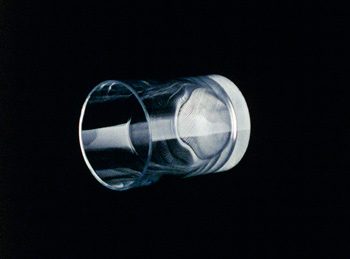Artist:
Mathias Poledna (born 1965 in Vienna, Austria; lives and works in Los Angeles, USA).
Materials:
16mm color film; no sound, 20 min.
Description:
“The point of departure for Poledna’s work is a crystal glassware set designed by Adolf Loos (1870–1933) and first manufactured in 1929 by the Viennese glassmakers L&J Lobmeyr. The so-called ‘bar set’ consists of twelve individual pieces: a fingerbowl, a champagne flute, a beer glass, a wine decanter, a water pitcher, a water glass, a double Old Fashioned whiskey tumbler, and red wine, white wine, dessert wine, sherry, and liqueur glasses. In contradistinction to traditional glass services of the era, whose individual pieces are usually quite different, each adapted to its particular purpose, and typically adorned with highly detailed decorations, all pieces in Loos’s bar set are based on a single highly reduced basic shape: a fully rounded glass with a flat bottom and sides at a right angle to the floor. The service’s individual components can be understood as ‘variations’ on this motif; their shapes are adapted to their intended purposes, but differences between them are limited to the exact ratio between the height and the diameter of a glass. Loos realizes his philosophical ideas about the progress of culture in the simplicity and precision of the bar set’s formal design. Yet unlike other comparable approaches to design of the same era, Loos combines formal reductionism and the absence of all ornamentation with the utmost refinement in the use of the material and the execution. The bottoms of these mouth-blown glasses, which are ground and polished by hand, bear diamond-cut facets, a fine-grained grid-like pattern that creates the subtlest scintillation. It would be difficult, however, to recognize this cultural-historical background in the work itself; to the contrary, it has been, as it were, compartmentalized, removed from the filmic representation and replaced by a spatial narrative of transparency, texture, absence, and motion. In the interplay between typological recording, detail shot, and shifting dramaturgy, this representation aims at a sort of choreography of objects that explores boundaries and transitions between abstraction, historical documentation, and the hyperaesthetic mise-en-scène of a commercial product.”
—”Mathias Poledna,” Portikus website.


